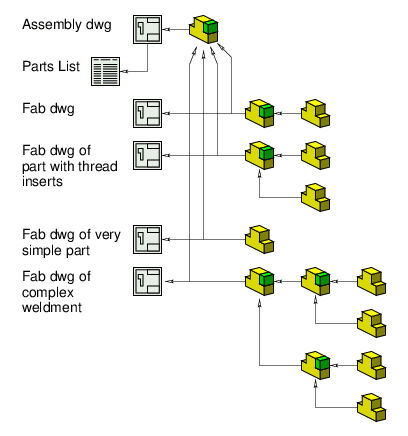drawoh,
Thanks again for the wealth of feedback. I think the way we intend to use the BOM for our ERP system might be different than the standard ERP implementation. We are still in the small business range (<150 but growing quickly) and I'm not sure how the larger companies handle these tasks. Some of the issues you bring up I don't think will be a problem for us, but I could be wrong!
drawoh said:
What does your production use? Drawings or models? The drawings are how you talk to the outside world.
drawoh said:
If your BOM does not come off the drawing, you are going to have to precisely reproduce whatever algorithm SolidWorks uses to order it BOM. You need to copy all the features and all the bugs.
Agreed, we use the drawings. These drawings have a BOM and item numbers associated, SW standard here. However, we don't need our item numbers to match up with the BOM in our ERP. They way we are using it is just inventory and ordering. I don't need to replicate the algo SW uses for its BOM, I just need a list of parts in each assy that need to be ordered.
drawoh said:
The next problem you have is that you will not control your assembly models. ERP will insist that your model generate their BOM in a predictable manner. They will dictate to you how to manage configurations, and what is or is not attached to your file. They may not care if you cannot do simulation, or organise your model around good design practice, and they may not care that they don't know how your CAD works.
We don't have amazing configuration control right now, that's something I'm working on and why I appreciate the feedback here! The program we are using to grab the SW generated BOMs will actually grab the weldment / sheet metal cut list as parts. It will grab anything not suppressed in a given configuration. From what I have been setting up as our best practices, it aligns very well. I have no doubts it will constrain us at times, but it is much better than our current state!
drawoh said:
Will your ERP people add features to their software when you ask them?
I don't know how that is relevant. What kind of features would I want them to add? I only care about getting them a list of parts to order and they can deal with timelines, stock, etc.
drawoh said:
Mechanical design and SolidWorks are part of your engineering department. Your warehouse, MRP and ERP are run by your accounting department. You need a nice, simple interface with them, like a BOM file generated from your reliable BOM program.
I think I'm aligned with you here. I have seen that Dassault has aligned the PDM generated BOMs more and more with the table style BOMs. I would imagine they use basically the same algo in the background, I can't point to any source that shows this though.
jassco said:
I completely agree with JHG. If you want to get BOMs from assembly models, then you need to follow ASME Y14.41 standard
3DDave said:
That would be ASME Y14.34-2013(Revision of ASME Y14.34-2008) Associated Lists
Hi Jassco and 3D Dave, thanks for joining the discussion. Can you explain why an list of items to order needs to meet either of these standards? My deliverable needs to meet the printed drawing, the model generated BOM is purely for internal ordering. I'm not sure if that falls under MBD or not. I've only really seen MBD as detail drawing replacement not as an assy dwg replacement.
I have no idea if our company is going about this in the right way. Right now all our deliverables rely on an individual manually placing a PO that isn't tied to any specific drawing number. It's a lot for our planners to keep track of and we constantly are missing parts. I think our ERP is a step in the right direction for ordering, but Engineering and Production will still be relying on the released drawings for final deliverables.

![[pc2] [pc2] [pc2]](/data/assets/smilies/pc2.gif)
